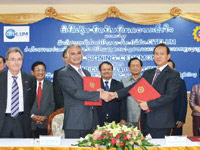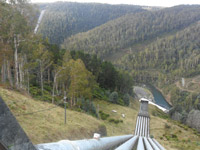Laos explains its hydropower policy
Laos explains its hydropower policy
Responsible and sustainable development of hydropower can be a catalyst for economic development and help bring people out of poverty, according to a senior Lao energy official.
“Very often we are asked, why does Laos choose hydropower?” said Deputy Minister of Energy and Mines, Mr Viraphonh Viravong, in discussions with hydropower experts from around the world. “We are taking every opportunity to explain the many good reasons.”
Mr Viraphonh said most people are aware that hydropower is clean, zero-carbon emission energy.
It's a renewable and non-consumptive use of water. No other method of power generation creates opportunities for providing water for human consumption and flood control, while generating clean and inexpensive electricity.
In addition, hydropower development is sustainable, meaning it is not used up like fossil fuel, and can continue to bring direct benefits to our people for decades to come.
Natural capital, that part of the economy derived from the natural environment including crops, pastureland, forest products, minerals and hydropower, accounts for 54 percent of the total wealth of Laos.
Of this, hydro electricity is responsible for 16 percent, or as much as 25 percent, depending on the social discount rate used to calculate its value.
Development of hydropower sites leads to improvement of living conditions, such as better education, health care, electrification and water supply for the local population. Roads, highways, bridges and economic opportunity are byproducts.
Development of water resources also involves programmes such as irrigation, environmental protection, enhanced commerce and trade, and specific benefits for resettled villagers including new homes, land, skills training and expanded opportunities for new livelihood, etc. The nation as a whole derives benefits from the development of power plants and sale of electricity such as payments of royalties, taxes and dividends.
Another obvious benefit is the production of reliable, renewable and competitive sources of electricity supply.
This benefit also applies to the wider region as Laos is contributing clean and renewable energy to the entire Mekong River Basin: 12,500 MW or 60,000 GWH of electricity generation will replace 5 million tonnes of oil equivalent of fossil fuels and the reduction of 30-60 million tonnes of CO2 emissions annually.
One project alone, the Xayaboury dam in northern Laos, will generate power that will reach 4 million users in Thailand and Laos.
This type of development promotes sustainable long-term trade among Asean countries. Increased energy interdependence improves the relationship between countries and decreases risk, further improving the investment climate of Southeast Asian countries.
Responding to those who seek to delay development of power-producing dams, Mr Viraphonh said that advanced technology can minimise potential impacts. It is essential for Laos to move ahead with hydropower development with the help of the best and most experienced engineers and consultants, he added.
“The government of Laos is responsible for the wellbeing and future of the Lao people,” Mr Viraphonh said. “That is why we will continue to develop hydropower -- responsibly, and practicably, with a commitment to internationally accepted sustainability standards -- as best we can.”
vientiane times















